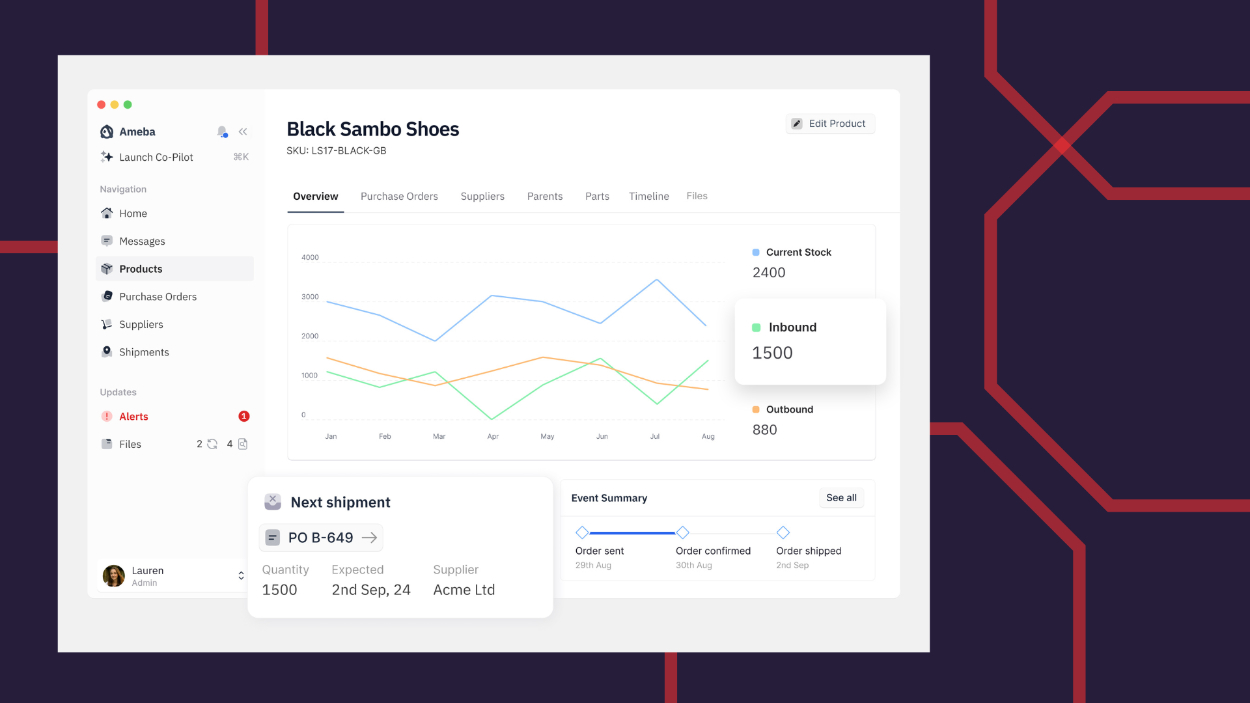Ahead of a headline speaking slot at this week’s ASBCI conference, and on the back of a $7 million seed round, Ameba (a platform designed to support brands and retailers in building a winning edge in their supply chain) partnered with The Interline to examine where fashion’s long-running search for truth has faltered – and to ask whether a grounded approach to artificial intelligence could get an ecosystem built on unstructured data back on track.
Fashion’s high-flying, experimental side might capture the most attention, but brands’ biggest priorities today are much more grounded. With the economic contours of the industry being continuously redrawn by shrinking consumer buying power, rising input costs, and the drive to do more with less, fashion companies’ strategic objectives are less centred in experimentation than they are in basic business continuity and balance sheets that threaten to tilt into the red.

Day-to-day, in late 2024, fashion brands and retailers have pricing and margin protection, efficiency and automation, and the various taps they can turn to control costs on top of their agendas. Alongside those, the same companies are also urgently seeking ways to forecast more accurately, to get faster to market to better compete with the dominance of ultra-speed heavyweights like Shein, and to generally cut the risk exposure inherent in everything they make.
And compounding those core challenges further, these businesses also need to meet a rising bar for transparency and disclosure, at the same time as finding new ways to both diversify their supplier base and to better engage and collaborate with their closest upstream partners.
To tackle these challenges, fashion brands and retailers need to make effective use of common tools and datapoints – from critical product attributes to accountability around decisions made in materials, sizing, sourcing, sampling and more.

To really deploy those tools, though, brand and retail businesses will need to be able to reliably find them. And although the industry has tried for many years to put all the information, assets, and capabilities it needs into one place – and to have them effectively work together – the reality has often fallen short of the vision.
That vision, though, has remained the driving force behind much of the software narrative in fashion for a decade or more. From technical specifications to transaction certificates, the industry has been told for years that essential product and process data resides in too many different, disconnected silos – and that the solution is to deploy a single system, with a set hierarchy and data schema, to centralise and consolidate it all.
But as much as technology has been sold on the promise of creating a single source of truth, the reality is less clear-cut.

Solutions such as PLM have been effective at bringing essential product data into a single location, and into a fixed structure. But while developers and users have been pursuing that ambition, the nature of “essential product data” has been morphing and expanding to encompass digital materials, information required for digital product passports, and much, much more. As a result, while core product data can reside in one platform today, only in rare cases is that also the platform where 3D assets are stored, or where mission-critical communication with suppliers is managed.
The scope of product data has become more diverse and unstructured over time, not less.
These narrow repositories of key information, and records of process and progress, also often need to be updated manually by designers, developers, merchandisers and other professionals – or they need to have changes pushed to them. And when the professionals in those roles are unavailable, or when they move from one brand to another, it becomes difficult for their colleagues and partners to stay up to date when sourcing or production timelines change, or to be notified when exceptions occur.

Adding even more complexity to this picture: business-to-business relationships have become looser and more informal in the last five years in particular, and the industry has seen a drift from most data at least living inside the “big enterprise” technology ecosystem, to the lines between professional and personal communication becoming blurred. Anyone working within fashion will be familiar with the ongoing trend for critical information residing in disconnected spreadsheets, homegrown databases, or PDFs shared via email. But these are really the tip of the iceberg compared to the volume of unstructured, non-normalised data that lives in messaging systems like WhatsApp and WeChat – or transcripts and action items from video conferencing and chat apps for work like Teams and Slack.
As a result, fashion today has many sources of truth – each of which contains only part of the picture – which need to be manually queried and combined to provide meaningful, actionable insights. A large segment of the fashion workflow is simply made up of systems, data, and people that don’t speak the same language – literally and figuratively – reshaping specific roles like Merchandising Director and Sourcing Manager into administration-heavy disciplines that involve more moving and reconciling of data than they do assembling assortments with better market fit, controlling costs, improving quality, and increasing agility.

What many – including London-based tech company Ameba, who have this month raised $7.1 million in seed funding with their vision – see as necessary now is for a universal source of truth to be layered on top of the existing scattering of different silos of unstructured information. And the big bet is that the major leaps made in RAG (retrieval augmented generation) and AI, combined with the right combination of industry knowledge and expertise, will be the key to unlocking this capability.
It’s important to understand, though, that the objective is not to introduce yet another platform with its own data stores. The fragmented, unstructured shape of fashion data will not be solved through the introduction of further fragmentation. And neither will it be addressed by brand and retail businesses – and their partners up and downstream – placing a new administrative weight on the shoulders of end users who are asked to onboard on yet another new environment.

To solve fashion’s lack of structure and centralisation, any new platform will need to sit above the existing, entrenched ecosystem. This is not “disruption” in the sense of replacement, but rather in the sense of providing an overarching way of creating sense from the entire corpus of critical product and supply chain data that already exists, using the new frontier of natural language interfaces and an intelligently designed application layer.
According to Ameba, this approach reduces the need to manually input data by 30%, but the true unlock could come from the use of AI to transform how fashion users approach the task of extracting insights, rolling up different data sources, and taking informed actions that pull in disparate, unstructured datapoints and generate order and actionable intelligence from them.
There are, of course, no shortage of technology companies promising to revolutionise the way fashion works by deploying generative AI in one or more use cases, or to automate a particular task. But there have been, so far, relatively few companies tackling the persistent challenge of enterprise data – and even fewer doing it with the exacting requirements of industries like fashion and retail in mind.

Ameba is looking to blend the right technology knowledge (one of its Co-Founders worked in engineering at the secretive AI and enterprise operating system giant Palantir) with direct retail industry experience, with Co-Founder Cedrik Hoffmann having previously founded and built an eCommerce business, and other strategic hires mixing similar hybrid skills across core fashion disciplines and strategic technology initiatives.
That combined skillset is behind the company’s approach to assigning different AI agents – using multiple different language-learning models – based on specific tasks and data sources. With Ameba acting as a top-level insights platform, those agents then cascade down into existing data sources (once granted access) and are capable of taking multi-step actions: exploring not just individual data sources, but the connections between them. This can be everything from identifying key attributes in a product’s technical specifications, to reading emails and WhatsApp messages (and their attachments) from suppliers.
Any mention of AI in this kind of business-critical context raises two questions, of course. How far can those agents, and the system they feed into, be trusted to generate usable, accurate insights? And is a brand’s sensitive data and intellectual property safe?
Ameba has clear answers to both of these concerns. Any notifications, updates, or insights surfaced from one or more existing systems and provided to the user by Ameba comes solely from the specific thread or database (the agents will not read a user’s entire inbox) and is accompanied by what the company calls an “AI explainability” tooltip. This can also be thought of as a citation or anchor: a direct link that leads to the enterprise system, the messaging platform, or the specific email that was used as the source.
This grounding is positioned as being the key to avoiding hallucinations and reliability issues (the user or brand’s own data is the only source from which insights can be surfaced), as well as providing the immediate benefit of allowing users to drill down into data contained in different systems without the need to manually roll them up.
Despite being built on the absolute bleeding edge of enterprise and consumer technology, these are simple, core principles in the most important sense for fashion as it stands today: they provide a way to turn unstructured data into clear, transparent, actionable information from which brands and retailers can then draw a direct line into improved profitability, organisation, efficiency, visibility, cost reduction and much more. A new unlock for a deeply embedded problem.

But the same pillars also have the potential to do much more – from real-time status tracking and AI queries, to automatic translation between brands and suppliers. Ameba’s aim is to do all this without replacing technology, or people, with AI, but instead providing a new, intelligent vantage point over them all – an angle from which a universal source of truth looks like it could actually be achievable.
To see Ameba’s vision for a supercharged supply chain, built by bringing structure to data, live, Cedrik Hoffmann will be presenting on 16th October 2024 at the AI-focused ASBCI conference in the north of England, where Ameba will also have a booth. The company was also profiled this month in TechCrunch.
